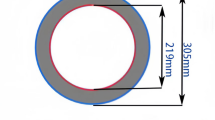Abstract
In order to estimate the flexural behaviour of reinforced concrete members, the stress–strain behaviour of the constituent materials must be well established. The behaviour of confined concrete is important to the designer in order to determine the quantity of the confining steel required in reinforced concrete column sections to achieve the ultimate curvatures required in seismic design for ductility. The objective of this study is to develop an analytical model for the confinement mechanism in rectangular reinforced concrete columns. The proposed model was established on the basis of the observations derived from several experimental studies conducted in past years and encompasses some features of already established models. The main variables examined in the model include the volumetric ratio of lateral reinforcement, the characteristics of steel and concrete and the effectiveness confinement coefficient. The comparison with other existing models illustrates the validity of the proposed equations.
Résumé
L’issue fondamentale permettant de définir la capacité flexionnelle des éléments en béton armé est la connaissance des lois contraintes déformations des matériaux constitutifs. Le comportement du béton confiné est donc l’élément capital qui devra permettre au concepteur d’estimer, par utilisation de l’armature transversale, la ductilité de courbure exigée pour une demande de ductilité désirée. L’objectif de cette étude est de développer un modèle analytique tenant compte du mécanisme de confinement dans les poteaux en béton armé. Le modèle est basé sur une analyse rigoureuse de modèles analytiques existants et une exploitation de données expérimentales réalisées durant les deux dernières décennies. L’étude a pris en considération l’influence des différents paramètres, notamment le rapport volumétrique des aciers transversaux, les caractéristiques mécaniques de l’acier et du béton et le coefficient efficace de confinement. La comparaison avec d’autres modèles existants confirme la validité des équations proposées.
Similar content being viewed by others
References
Règles Parasismiques Algériennes, RPA 99, CGS Alger, 2000
Sheikh SA, Uzumeri SM (1982) Strength and ductility of tied concrete Columns. J Struct Div 106(ST5):2703–2723
Moehle JP, Cavanagh T (1985) Confinement effectiveness of crossties in RC. J Struct Eng 111:2105–2120
Mander JB, Priestley MJN, Park R (1988) Observed stress–strain behavior of confined concrete. J Struct Eng 114(8):1827–1849
Hoshikuma J, Kawashima K, Nayaga K, Taylor AW (1994) Stress–strain model for confined RC in bridge piers. J Struct Eng 123(5):624–633
Bousalem B, Chikh N, Djebbar N (2004) Etude des aspects qualificatifs du confinement sur la résistance et la ductilité des zones critiques des structures en béton’, Rapport de recherche N°2, Projet CNEPRU J2501/04/02/03, LMDC – Université Constantine
Park R, Priestley MJN, Gill WD (1982) Ductility of square confined concrete columns. J Struct Eng 108(4):929–950
Sheikh SA, Uzumeri SM (1982) Analytical model for concrete confinement in tied columns. J Struct Div 108(ST12): 2703–2722
Mander JB, Priestley MJN, Park R (1988) Theoretical stress–strain model for confined concrete. J Struct Eng 114(8):1804–1826
Saatcioglu M, Razvi SR (1992) Strength and ductility of confined concrete. J Struct Eng 118(6):1590–1607
Sheikh SA,Yeh CC (1982) Flexural behavior of confined concrete columns. ACI J May–June:389–404
Popovics SA (1973) Numerical approach to the complete stress–strain curve concrete. Cement Concrete Res 3:583–599
CBA 93, Code du Béton Algérien, CGS Alger, 1993
Scott BD, Priestley MJN, Park R (1982) Stress–strain behaviour of concrete confined by overlapping hoops at low and high strain rates. ACI J Jan–Feb:13–27
Bing L, Park R, Tanaka H (2001) Stress–strain behavior of high strength concrete confined by ultra high and normal strength transverse reinforcements. ACI Struct J May–June:395–406
Author information
Authors and Affiliations
Rights and permissions
About this article
Cite this article
Bousalem, B., Chikh, N. Development of a confined model for rectangular ordinary reinforced concrete columns. Mater Struct 40, 605–613 (2007). https://doi.org/10.1617/s11527-006-9172-2
Received:
Accepted:
Published:
Issue Date:
DOI: https://doi.org/10.1617/s11527-006-9172-2




